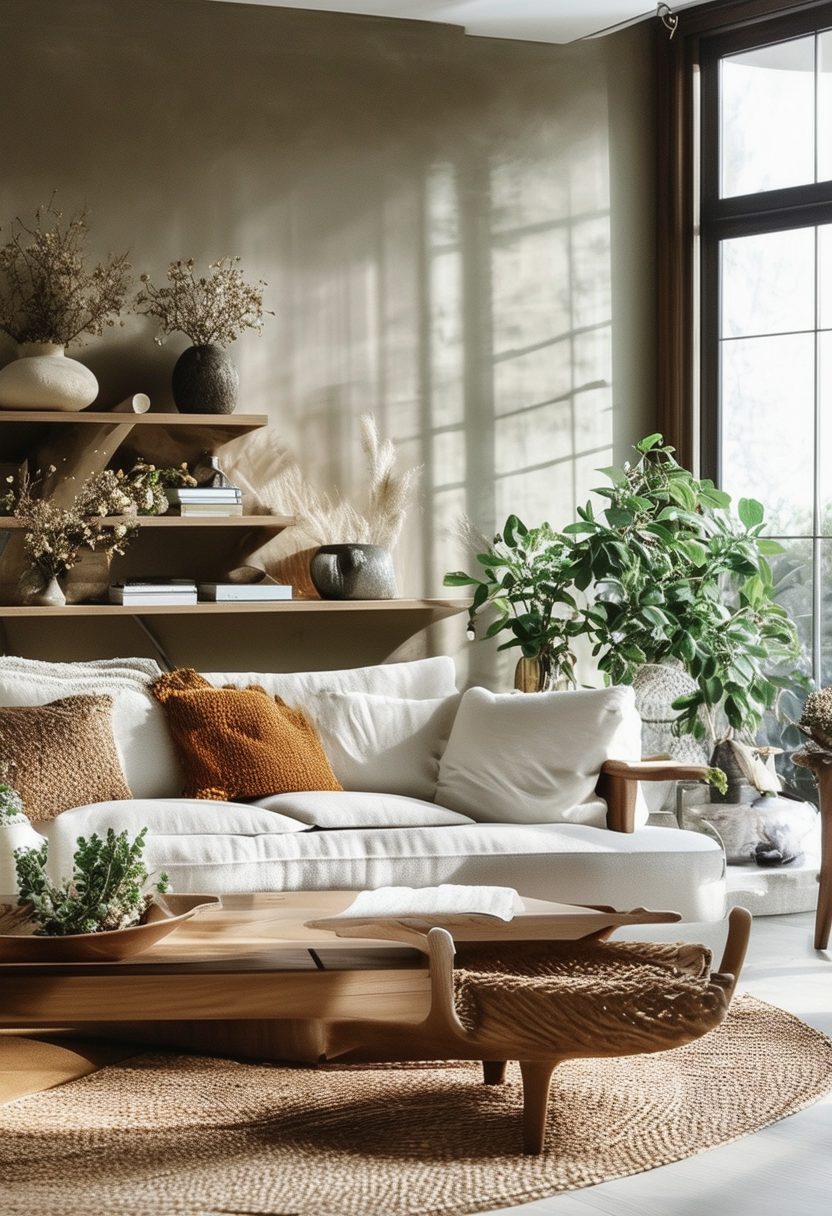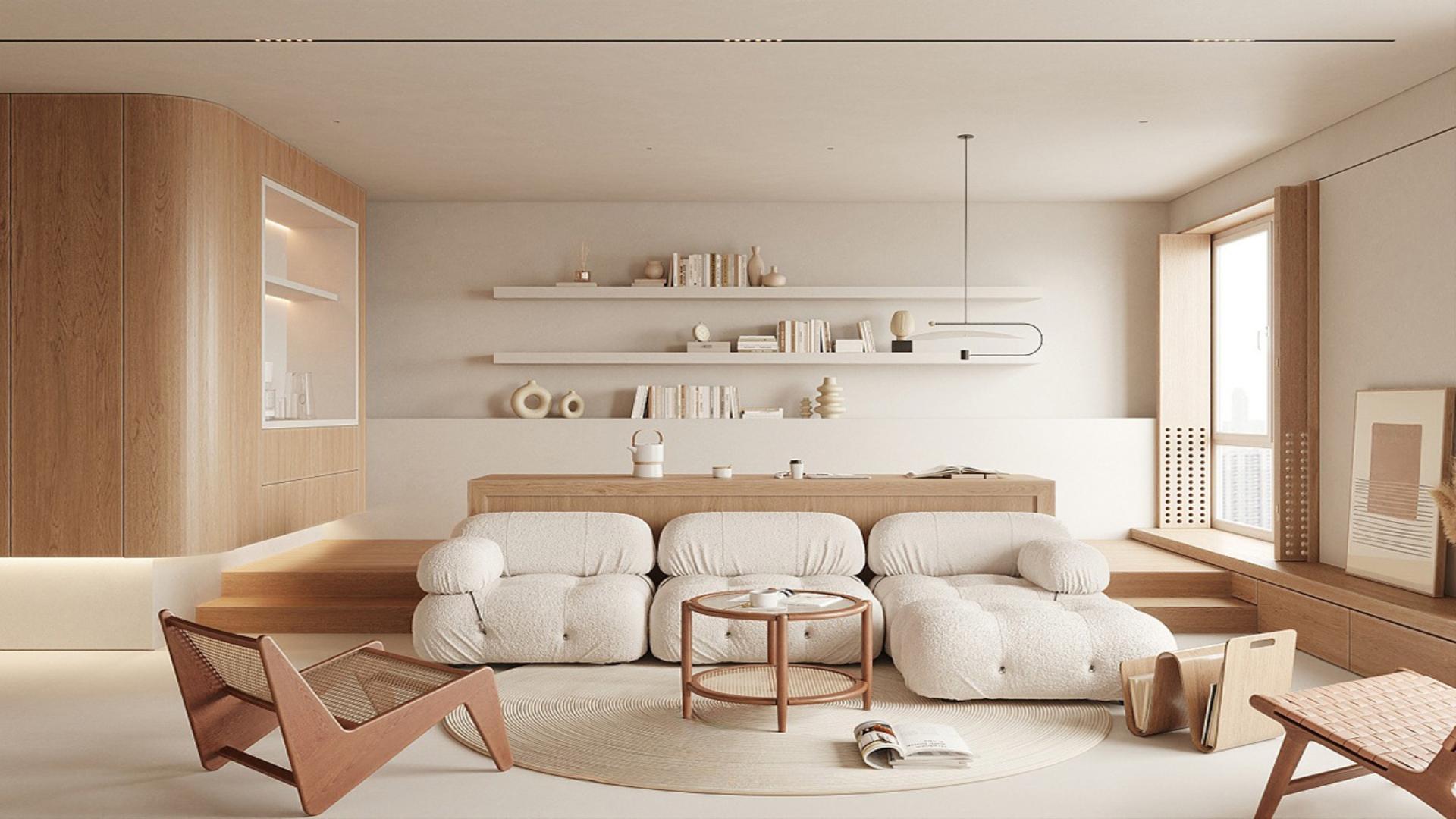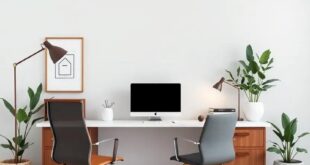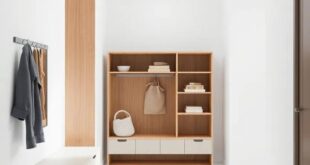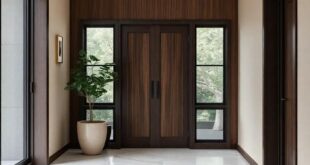Transforming your living environment can be both an exciting and daunting task. With endless choices and styles at your fingertips, it’s easy to feel overwhelmed. That’s where we come in! In this carefully curated listicle, we present 24 inspiring interior design ideas that cater to every space in your home. Whether you’re looking to refresh your living room, create a serene bedroom sanctuary, or revamp your workspace, these ideas promise to ignite your creativity and provide practical solutions.
Get ready to explore innovative concepts, clever design hacks, and timeless trends that will help you showcase your unique style while enhancing functionality. From color palettes and furniture arrangements to accessories and ambient lighting, each entry offers thoughtful insights to elevate your space. Dive in and discover how you can effortlessly transform your surroundings into a reflection of you!
Embrace biophilic design: Nature-inspired elements enhance your interior design
Integrating nature-inspired elements into your interior spaces can profoundly transform your home, creating a sense of tranquility and connection to the outside world. Consider incorporating natural materials such as wood, stone, or bamboo into your design. This not only enhances aesthetic appeal but also promotes sustainability. Think about features like reclaimed wood furniture, stone accent walls, or bamboo flooring. To further embrace biophilic design, introduce indoor plants; they not only purify the air but also bring vibrant life to your surroundings. Utilize wall planters or hanging terrariums for a sophisticated touch, or group various sizes of pots to create a lush indoor garden.
Maximizing natural light is an essential aspect of biophilic design that can significantly improve your living areas. Consider using large windows, skylights, or glass doors to bring the beauty of the outdoors in. When selecting color palettes, opt for earthy tones like greens, browns, and neutrals that reflect the colors found in nature. Additionally, textures play a crucial role; consider incorporating elements such as woven textiles, natural fibers, and stone finishes to create layered, inviting spaces. The goal is to foster a sense of harmony and well-being that mimics the serenity of natural environments. For more inspiration on biophilic design, check out the resources available at ArchDaily.
Bold color palettes: Vibrant hues can transform your interior design instantly
Transforming your space with bold color palettes can create a stunning visual impact that energizes and uplifts the atmosphere of any room. Rich jewel tones, such as emerald greens, deep sapphires, and luxurious plums, can be paired together to create a sophisticated yet striking look. Think about adding a vibrant accent wall painted in a fiery red or a sunny yellow, which can serve as a focal point against more neutral furnishings. Alternatively, using bright, saturated hues for furniture and decor items—like a cobalt blue couch or scarlet cushions—can instantly breathe life into your interiors.
When exploring vibrant color combinations, consider how they interact with natural light and your existing decor. Mixing warm and cool tones can bring balance and interest; for example, pairing burnt orange with teal or soft lavender with mustard yellow can create an intriguing contrast. To visualize these combinations, check out the inspiring color wheel on Color Matters. Here’s a simple table showcasing popular vibrant color pairings:
| Color Pairing | Vibe |
|---|---|
| Teal & Coral | Energetic and playful |
| Royal Blue & Mustard | Sophisticated and bold |
| Magenta & Lime Green | Fresh and modern |
| Burnt Orange & Navy | Warm and inviting |
Minimalist aesthetics: Less is more in modern interior design spaces
In modern interior design, the philosophy of “less is more” champions the idea that simplicity can yield profound beauty. By embracing clean lines and open spaces, minimalist aesthetics invite tranquility into our homes. Key elements such as neutral color palettes, functional furniture, and natural materials create a serene atmosphere, allowing individuals to appreciate their surroundings fully. One way to achieve this is through thoughtful organization; decluttering surfaces and opting for hidden storage solutions not only maximizes space but also enhances the overall sense of calm. Incorporating trendy pieces like a sleek sofa or understated artwork can add character without overwhelming the visual balance.
A minimalist approach enhances the feeling of spaciousness and encourages intentionality in design choices. This design style often incorporates statement lighting that doubles as functional decor and emphasizes architectural features. Rather than filling a room with numerous ornaments, the focus shifts to highlighting a few carefully selected pieces. Accessories, when chosen thoughtfully, act as conversation starters rather than distractions. Thoughtfully placed greenery or a single sculptural item can provide a refreshing contrast to the simplicity around it, enriching the space while adhering to minimalist principles. For more inspiration on how to implement minimalist designs, check out Architectural Digest for trends and guidance.
Multifunctional furniture: Maximize utility in small spaces with smart interior design
- Storage Ottomans: These versatile pieces can serve as footrests, seating, or even coffee tables while providing hidden storage for blankets and magazines.
- Convertible Sofas: Perfect for accommodating guests, these sofas can easily convert into comfortable beds, saving space without sacrificing style.
- Murphy Beds: Innovative wall beds are fantastic for making the most of limited square footage; they allow you to reclaim valuable floor space during the day.
- Nesting Tables: These tables tuck neatly together when not in use but can be spread out for entertaining, making them both practical and stylish.
| Furniture Type | Utility |
|---|---|
| Hidden Desks | Transforms into a workspace and hides away when not in use. |
| Foldable Dining Tables | Compact for everyday use, extends for gatherings. |
| Bookshelf Ladders | Stylish and functional, provides storage and access to upper shelves. |
Making every square inch count is a priority in small spaces, and multifunctional furniture is your best ally. Beyond the obvious benefits of functionality, these smart designs often feature contemporary aesthetics that can elevate the overall style of your home. Imagine a stylish coffee table that doubles as a dining surface or decorative storage bins that also serve as seating options; the possibilities are endless. Brands like Wayfair showcase countless options for stylish multifunctional pieces that can seamlessly fit into any décor.
Integration of furniture into your lifestyle can enhance usability without cluttering your space. Opt for designs that reflect your taste while ensuring maximum utility; multifunctional furniture should not only be practical but also complement your personal interior style. For instance, a chic media console can house your entertainment gear while providing extra storage for books and games. Browse through IKEA for more ingenious designs that can transform your small spaces into multifunctional marvels.
Vintage meets modern: Eclectic interior design creates unique character and charm
Embracing eclectic interior design allows you to blend vintage charm with modern aesthetics, creating spaces rich in character and personality. The combination of retro furniture pieces, like a mid-century armchair paired with sleek, contemporary lighting, can dramatically elevate the atmosphere of your living area. To enhance this fusion, consider incorporating a mix of textures—think velvet cushions alongside leather sofas or distressed wood tables paired with glass accents. Such contrasts not only add visual interest but also invite conversations around the unique relationships between styles.
When curating your eclectic space, pay attention to color palettes that harmoniously tie together your various elements. Opt for a base color that compliments both eras, such as a rich navy or warm terracotta, and use vintage-inspired artwork or bold prints to add flair. Layering is essential; mix patterned rugs with minimalist furniture to create a cozy yet dynamic look. Incorporating plants can also breathe life into your design; consider using vintage planters or modern ceramic pots to balance old and new. Explore more inspiration at architecturaldigest.com for tips on making your eclectic style truly shine.
Statement lighting: Illuminate your interior design with eye-catching fixtures
Lighting is no longer just a functional element in interior design; it has become a central feature that can elevate the overall aesthetic of any space. Eye-catching fixtures such as oversized chandeliers, sculptural pendant lights, or artful wall sconces can act as focal points, drawing the eye and sparking conversation. Consider incorporating elements of texture and color—a brushed brass finish or a vivid glass lamp can add depth and personality. Moreover, layering light with multiple sources allows for flexibility in ambiance, making it as cozy or vibrant as the occasion demands.
When selecting fixtures, don’t shy away from unconventional shapes and designs. Geometric lighting can infuse a modern vibe, while vintage-inspired options may evoke a sense of nostalgia. For a harmonious look, be sure to coordinate the materials and colors of your fixtures with other elements in the room, such as furniture and art. For inspiration, explore the wide variety of styles available on Wayfair. the right lighting not only illuminates but also enhances the beauty and function of your interior spaces.
Textured layers: Add depth to your interior design with varied materials
Incorporating varied materials into your interior design creates an inviting atmosphere that captivates the senses. Wood, metal, and textiles can be layered together to create a rich tapestry that exudes warmth and character. Consider using reclaimed wood on your walls to bring an organic touch, combined with sleek metal fixtures like hardware or lighting to introduce a modern edge. For an added layer of sensory delight, integrate textured fabrics such as velvet throw pillows or woven blankets, adding a soft counterbalance to the harder surfaces. This not only enhances visual interest but provides a tangible comfort that invites interaction.
Mixing these contrasting materials can also define different areas within open spaces. For instance, a metal coffee table paired with a woven area rug delineates the seating area, while ceramic planters filled with lush greenery can soften transitions between zones. To make your design decisions easier, here’s a quick comparison of material characteristics worth considering:
| Material Type | Texture | Use Case |
|---|---|---|
| Wood | Warm, natural | Furniture, wall accents |
| Metal | Cool, sleek | Hardware, lighting |
| Textiles | Soft, inviting | Pillows, rugs, curtains |
| Ceramics | Textured, earthy | Planters, decorative pieces |
By skillfully layering different materials, you can create an interior that not only reflects your personal style but also tells a story. Each texture adds depth and invites your guests to explore the nuances of your space. For further inspiration on incorporating textures into your design, visit Apartment Therapy.
Open floor plans: Foster connection through airy interior design layouts
Embracing open floor plans is a transformative journey towards cultivating connection and enhancing the flow of your home. These airy layouts seamlessly combine living, dining, and kitchen areas, promoting social interaction and family bonding. You can create distinct zones within a unified space using strategic furniture placements, area rugs, or varying color schemes. By integrating elements like oversized islands or spacious breakfast bars, you not only provide functional spots for meals but also encourage intimate gatherings, bridging the gap between culinary adventures and casual conversations.
To amplify the airy feel, consider incorporating large windows or glass doors that invite natural light and the outdoors inside. This design choice not only amplifies the sense of openness but also fosters a calming ambiance that enhances well-being. Decorative plants can serve as subtle dividers while also purifying the air. Elevate your space by mixing textures like smooth wood, soft fabrics, and metallic finishes for a more dynamic visual appeal. Here are a few essential features to consider for your open floor design:
- Integrated Lighting Solutions: Pendant lights and recessed lighting can create layers of illumination.
- Multi-functional Furniture: Consider sofas that convert into sleeping areas or expandable dining tables.
- Open Shelving: Display treasured items and create a sense of flow to keep your interior visually engaging.
| Element | Impact |
|---|---|
| Natural Light | Enhances mood and creates a welcoming atmosphere |
| Vertical Space | Draws the eye upward, highlighting ceiling height and architectural features |
| Flexible Zoning | Allows for reconfiguration of spaces as needs change |
For more creative insights on open floor plans, check out House Beautiful. You’ll discover how to blend stylish functionality with effortless elegance in your home.
Cozy nooks: Create inviting spaces with thoughtful interior design touches
Creating inviting spaces within your home can be accomplished through thoughtful interior design touches that transform ordinary corners into cozy nooks. Start with comfortable seating options such as oversized armchairs, bean bags, or a daybed nestled by a window. Layer in plush cushions and a soft throw to enhance comfort and add texture. Incorporating elements like a small side table to hold warm beverages or books also promotes relaxation. Consider using warm lighting, such as table lamps or string lights, to create an intimate atmosphere that invites people to unwind.
Don’t forget to personalize your nook with decorative accents that reflect your taste. Add shelves filled with your favorite reads, or hang art pieces that resonate with you. Greenery can breathe life into the space, so incorporate plants or fresh flowers for a touch of nature. Use area rugs to define your cozy nook, bringing together the design elements and creating an inviting zone. A well-designed nook can serve as a perfect escape for reading, meditation, or simply enjoying a moment of quiet reflection. For more inspiration on creating warm spaces, visit apartmenttherapy.com.
Scandinavian simplicity: Clean lines and functionality define this interior design style
Embracing the essence of Scandinavian design means celebrating minimalism without sacrificing warmth or comfort. Interiors often feature neutral color palettes, which evoke a sense of tranquility, allowing the harmonious balance of light and space to take center stage. Accessories are kept to a minimum, but when included, they reflect both elegance and practicality. Think of handcrafted pieces that add a personal touch—ceramic pots, woven textiles, or elegantly framed artwork. This approach ensures that each item serves a purpose while contributing to an overall cohesive look.
Functionality reigns supreme in this aesthetic, where furniture often doubles as storage solutions to maintain an uncluttered environment. Consider the use of modular shelving systems designed to adapt to various needs, or multifunctional seating that can transform from a cozy chair to a smart storage unit. The lines of the furniture are clean and crisp, steering clear of excessive ornamentation, which promotes a feeling of clarity and space. To gain more insights into achieving this timeless look, visit Houzz for additional inspiration.
Artistic wall treatments: Elevate your interior design with wallpaper or murals
For those seeking to inspire and energize, themed murals can elevate a child’s playroom or a creative studio with vibrant images that go beyond mere decoration. Choose from a palette of bold colors or soft pastels based on the mood you want to cultivate. Explore options like removable wallpaper, which offers flexibility and allows for updates without commitment. For inspiration, check out designsponge.com to discover a wealth of examples that demonstrate how artistic wall treatments can redefine spaces.
Earthy tones: Use organic colors to create calm interior design vibes
Transform your living spaces into serene havens by incorporating earthy tones that echo the natural world. Consider painting your walls in soft browns, gentle greens, or creamy beiges to establish a foundation for tranquility. Furniture in shades such as rustic terracotta or subtle olive green can further enhance this organic feel. Layering these colors through textiles like throws, cushions, and area rugs allows you to play with texture and depth, promoting a cozy atmosphere. Integrate plants with rich earth-toned pots to subtly bring the outdoors in while accenting the calm color palette.
A well-thought-out color scheme can also be enhanced by choosing complementary materials, reinforcing the connection to nature. Consider incorporating wood, stone, and linen in your decor. These elements not only align with an earthy aesthetic but also improve the overall ambiance of your space. For instance, a stunning wooden dining table paired with rustic clay dishes or a stone fireplace surrounded by earthy-hued tiles can serve as focal points that ground the room. Explore more about earthy tones and their impact on design at Apartment Therapy, where you can find additional insights and tips on creating a calming environment.
Layered rugs: Add warmth and dimension to your interior design
Layered rugs are a fantastic way to introduce both warmth and dimension into your home. By strategically placing one rug over another, you can create a rich visual texture that transforms the overall ambience of your space. For instance, pairing a bold, patterned rug with a neutral base can add a touch of flair to minimalist interiors, while using a thick, shaggy rug over a flatweave can enhance comfort in casual seating areas. Don’t be afraid to experiment with colors, patterns, and textures that reflect your personal style, as this layering technique can lead to a stunning focal point in any room.
To master this design approach, consider the following tips:
- Mix and match sizes: Use a large rug as your base and layer a smaller one on top to create contrast.
- Focus on color harmony: Choose rugs that complement each other to maintain a cohesive look.
- Incorporate different materials: Combining jute with wool or silk can enhance the sensory experience.
- Think about functionality: Layer rugs can also provide warmth underfoot, especially in colder months.
| Rug Type | Ideal Location | Texture |
|---|---|---|
| Shag Rug | Living Room | Soft & Cozy |
| Jute Rug | Entryway | Natural |
| Silk Rugs | Bedroom | Luxurious |
For more inspiration on using layered rugs in your home, check out MyDomaine, where creative interior design ideas abound.
Customized shelving: Showcase your personality through tailored interior design solutions
Moreover, the arrangement of your shelving can communicate your personality and interests. Create a thematic display that showcases your hobbies, such as a library-inspired wall filled with your favorite books, or a display case for your intriguing collectibles. You can also incorporate integrated lighting, such as LED strips or spotlights, to enhance certain pieces and create a warm ambiance. Customized shelving is about much more than just storage; it’s a canvas for showcasing your individuality. For inspiration, you can explore resources on Houzz to see how others have personalized their spaces.
Sustainable materials: Eco-friendly choices enhance your interior design and the environment
Incorporating eco-friendly materials in your interior design not only adds a unique charm but also supports sustainability. Consider using bamboo, a fast-growing grass that offers durability while boasting a rich texture. Another fantastic choice is recycled metal, perfect for creating stunning light fixtures or furniture pieces, merging modern aesthetic with environmental responsibility. Additionally, natural fibers such as jute and hemp can be woven into rugs and upholstery, imparting a warm and inviting feel to any space while being biodegradable and easily renewable.
When you select materials like cork for flooring or wall panels, you’ll enjoy an environmentally friendly option that provides excellent insulation and a distinctive look. Reclaimed wood is another beautiful choice that not only reduces deforestation but tells a story with each grain. Explore the plethora of sustainable options available and create a home that reflects your values. To delve deeper into eco-friendly design aspects, check out architecturaldigest.com. Here’s a quick comparison of some sustainable materials:
| Material | Benefits | Uses |
|---|---|---|
| Bamboo | Fast-growing, lightweight, durable | Floors, furniture, decor |
| Recycled Metal | Reduces waste, modern look | Light fixtures, art, furniture |
| Naturally-dyed Fabrics | Less harmful chemicals, unique colors | Cushions, curtains, attire |
| Cork | Insulates, sustainable harvesting | Floors, wall coverings |
| Reclaimed Wood | Unique character, eco-conscious | Furniture, shelving, accent walls |
Indoor-outdoor flow: Blurring boundaries creates harmony in interior design
Embracing the enchanting concept of blurring boundaries between indoors and outdoors not only enhances the aesthetic of your space but also promotes a sense of tranquility. To achieve this, consider incorporating large windows or glass doors that invite natural light and offer unobstructed views of your garden or patio. The seamless transition can be further accentuated with an open floor plan that allows the living area to flow directly into outdoor spaces, creating a harmonious environment. Elements like indoor plants or a cohesive color palette between both spaces can further blur the lines, making the transition feel natural and intentional.
Integrating materials commonly found outside can also enhance this connection, such as using natural stone or wooden textures in both your interior and exterior designs. Outdoor rugs, cushions, and lighting applied strategically can make the outdoors feel like an extension of your home. Additionally, consider adding a fire pit or outdoor kitchen that complements your indoor kitchen, emphasizing the allure of outdoor gatherings. Ultimately, the goal is to create a cozy retreat that feels unified regardless of where you are, allowing the joys of nature to infuse your everyday living. For more ideas, check out houzz.com for stunning visual inspirations that bring these concepts to life.
Unique focal points: Draw attention with standout pieces in your interior design
Creating a unique focal point in your space can instantly elevate the aesthetic and draw eyes to that specific area. Consider incorporating statement artwork, such as a large canvas or a striking sculpture that reflects your personal style. Placing it in a prominent position, like above a fireplace or as a centerpiece on a feature wall, not only enhances the room’s character but also sparks conversation among guests. Other options include utilizing bold furniture pieces—think of a vibrant armchair or an intricately designed coffee table that combines functionality with form. These standout items can serve as anchoring points, guiding the overall decor and color palette of the space.
Another innovative approach is to use unique lighting fixtures that serve both practical and decorative purposes. A dramatic chandelier or an oversized pendant light can become an eye-catching element, highlighting areas like dining tables or living room seating arrangements. You might also explore textured wall treatments such as reclaimed wood paneling or textured wallpaper to add depth and interest, making them a focal point without overwhelming the space. Additionally, incorporating mirrors in strategic locations not only reflects light but also creates an illusion of space, enhancing both aesthetic and functionality. For more design inspiration, check out architecturaldigest.com to explore various interior design styles and ideas that bring unique focal points to life.
Personal touches: Infuse individuality into your interior design with curated decor
To create a home that truly reflects your personality, consider incorporating curated decor that tells your unique story. Start with personal artifacts such as travel souvenirs, family heirlooms, or pieces from local artisans. These items can serve as focal points, drawing the eye and sparking conversation among guests. Feel free to mix materials and styles; a rustic wooden bowl can beautifully contrast with sleek metal sculptures, adding depth and intrigue to your space. Don’t shy away from displaying your hobbies, whether it’s a vibrant collection of vinyl records or bespoke pottery that showcases your creative flair.
Further personalize your environment by investing in custom artwork that resonates with your tastes. Support local artists by commissioning pieces that speak to your experiences or values. You can also create a gallery wall featuring a combination of framed pictures, inspirational quotes, and eclectic prints in various sizes, ensuring each piece contributes to the overall narrative of your space. Consider using a color palette that reflects your mood and enhances the atmosphere of the room. Check out dwell.com for inspiration on blending design styles seamlessly. Additionally, embrace textures—soft linens, rustic woods, and vibrant ceramics can weave a rich tapestry that invites comfort and warmth into your home.
Smart storage solutions: Tidy up clutter through innovative interior design ideas
Maximizing space while maintaining a stylish aesthetic is the essence of innovative interior design. Consider multi-functional furniture; a sofa that transforms into a bed or an ottoman that doubles as storage can significantly declutter a room. Wall-mounted shelves provide an attractive way to display books and décor without taking up floor space. In kitchens, utilizing the vertical space with hanging pot racks or pegboards keeps essentials within reach while maintaining a clean countertop. These alternatives not only organize but also create a visually pleasing environment, making small areas feel more open and inviting.
Another captivating idea is to incorporate hidden compartments. Beds with drawers beneath or side tables with concealed spaces can keep items out of sight yet easily accessible. Use decorative baskets within cabinets or sliding drawer organizers to keep frequently used items handy while maintaining a tidy appearance. Embrace the beauty of multifunctionality by including stylish storage bins or collapsible boxes that blend with your design theme. By implementing these solutions, every nook and cranny can serve a purpose without sacrificing charm.
| Storage Solution | Benefits |
|---|---|
| Multi-functional Furniture | Maximizes space & offers versatility |
| Wall-mounted Shelves | Utilizes vertical space |
| Hidden Compartments | Keeps clutter out of sight |
| Decorative Baskets | Combines style with functionality |
For additional inspiration on clever storage solutions, visit Apartment Therapy to explore more creative ways to create harmony in your home.
Eclectic art displays: Curate collections that reflect your style in interior design
Transform your living space into a vibrant gallery by curating eclectic art displays that speak to your personality and style. Whether you’re drawn to whimsy or sophistication, combining various art forms and pieces can create a visual narrative that captures your essence. Consider blending original artwork, photographs, and print reproductions into a cohesive collage. Arrange them in an asymmetrical layout for a casual, bohemian vibe or a symmetrical pattern for a more polished look. Layering textures—think wooden frames, canvas, and metal—can add depth and intrigue.
Don’t forget to incorporate personal touches, such as local artists or travel souvenirs, which can tell your unique story and spark conversations. Experiment with different sizes and orientations; a large piece can anchor a room, while smaller paintings can create an interesting contrast. Use floating shelves, gallery walls, or even hanging art installations to showcase your stash. For further inspiration, check out Artsy for an extensive range of contemporary art styles and artists to incorporate into your design.
Natural light maximization: Brighten spaces through strategic interior design choices
Transform your home into a sunlit sanctuary by incorporating design elements that enhance the natural light flow. Strategic placement of mirrors can amplify sunlight, creating an illusion of larger, brighter spaces. Mounting mirrors opposite windows or in corners encourages light to bounce around the room, enhancing its vibrancy. Complement this with light-colored walls, such as soft whites or pastels, as they reflect light rather than absorb it, making even the smallest room feel airy. Consider using translucent window treatments, like sheer curtains, that allow sunlight to filter in while preserving your privacy.
Beyond color and placement, furniture arrangement plays a pivotal role in light maximization. Position furniture away from windows to avoid obstructing the flow of light; opt for raised furniture pieces, like a set of modern legged chairs or tables, which allow light to flow underneath. Embrace open shelving over solid cabinetry to create a lighter, more open feel while maintaining a stylish aesthetic. For those dreamy sun-kissed mornings, consider adding skylights or strategically opening spaces between rooms, which permits natural illumination to dance throughout your home. For more design inspiration, visit Architectural Digest.
Indoor plants: Introduce greenery to enhance your interior design atmosphere
Transforming your living space into a vibrant oasis is easier than you think. Introducing indoor plants not only infuses life into your home but also elevates your interior design. Whether you choose elegant snake plants or lush ferns, the right greenery can create a tranquil atmosphere that complements your existing decor. Consider arranging your plants in stylish pots or using hanging planters to draw the eye upward, making your rooms feel more expansive. For an added touch of sophistication, placing a miniature bonsai on your coffee table or a tall palm in a corner can become stunning focal points that capture attention.
When selecting plants, think about how they embody your personal style and the functionality they provide. Incorporating greenery into your design approach can also improve air quality, making your home not just visually appealing but also healthier. Opt for fragrant herbs in the kitchen or vibrant succulents on your windowsill to blend both aesthetics and practicality. For detailed tips on creating a plant-friendly home, check out The Sill.
Monochromatic schemes: Simplify your color choices for striking interior design elegance
Embracing a monochromatic color scheme can transform any space into a haven of sophistication while simplifying your design choices. By selecting a single hue and varying its shades, tints, and tones, you can create a seamless flow throughout your interiors. Consider opting for a deep navy as your primary color—this rich tone can evoke a sense of calm while making the room feel more expansive. Pair it with lighter shades of navy, such as sky blue or powder blue, for a layered effect. You could enhance the visual interest further by playing with textures like velvet, linen, or leather, ensuring that every element of the room feels cohesive yet dynamic.
Monochromatic schemes also allow for creative expression through decorative elements. Think of incorporating artistic accessories in varying shades of your chosen color, such as cushions, rugs, or even art pieces. For example, a minimalist living room adorned with cream-colored walls, light beige furniture, and deeper taupe accents can exude both warmth and tranquility. Adding plants with dark green foliage can introduce an organic touch that complements the color palette without overwhelming it. For more inspiration on how to implement these design principles, explore the resources available at houzz.com.
Seasonal decor updates: Keep your interior design fresh with easy swaps
Transforming your living space with seasonal decor updates is a fantastic way to breathe life into your interiors without committing to a complete overhaul. Simple swaps can instantly refresh the vibe of any room. For a cozy autumn feel, consider replacing your light cotton throws with plush, textured blankets in warm hues or deep earth tones. Accent pillows featuring seasonal patterns—think leaves, pumpkins, or cozy plaids—can elevate your sofa while adding comfort. In the spring, consider swapping out heavier items for lighter, airy fabrics in pastel shades or floral prints, bringing a touch of nature indoors. Small touches, such as changing out a few picture frames or introducing seasonal art prints, can significantly change the atmosphere, allowing your home to reflect the beauty of nature throughout the year.
To add an even more playful approach to your seasonal updates, think about incorporating themed accessories into your design. Natural elements like pine cones or smooth stones arranged in a decorative bowl can create an organic feel during the fall and winter months. As summer approaches, clear glass vases filled with fresh flowers or colorful fruit can bring brightness and liveliness to your kitchen or dining area. Rotate decorative items on your shelves, such as candles or figurines, through the seasons—this keeps your space dynamic and interesting. For more ideas on seasonal decor inspirations, visit housebeautiful.com.
Wrapping Up
As we’ve journeyed through these 24 inspiring interior design ideas, we hope you’ve found a spark of creativity that ignites your own home transformation. Each space, no matter how big or small, holds potential for beauty and functionality. Remember, the power of design lies not just in trends, but in the personal touch you bring to each corner. Whether you’re dreaming of a serene retreat, a vibrant gathering place, or a clever multifunctional area, let your imagination guide you. Embrace the process, experiment with different styles, and most importantly, create a space that reflects who you are. Happy designing!
 decorifusta Garden and patio decoration inspiration
decorifusta Garden and patio decoration inspiration
